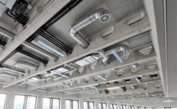Holedeck
Script error: No such module "Draft topics".
Script error: No such module "AfC topic".
Holedeck (hˈo͡ʊldɛk) is a type of reinforced concrete structure characterised by lateral perforations, which reduce the volume of concrete and allow the passage of installations.
Design[edit]
The design is based on the principles of the lightened, triangulated bird bone structure.
For the construction of the transverse windows, special removable and reusable truncated cone-shaped moulds are used, which are extracted laterally after the concrete has been poured. This technology was patented and developed by the Spanish architect Alberto Alarcón García.

Configurations[edit]
The structure has two configurations: unidirectional or in orthogonal or triangular grid. For lattice arrangements the structural behaviour and calculation is similar to that of other waffle slabs.

In the case of the one-way system, the layout is similar to a conventional in-situ joist and beam truss. The shear of the structure is solved by the literal application of the tie rod model and is calculated in a similar way to concrete structures without perforations.
These structures are suitable for spans of between six and twenty-two metres, making them an optimal choice for the construction of sustainable concrete structures.
Features[edit]
- Lower consumption of concrete and steel. The compression layer has a minimum thickness of between 8 and 12 cm, strictly sized according to structural fire regulations. The joists are spaced between 1 and 3 metres apart, thus making structural use of this compression layer, lightened by the perforations. For further optimisation they can be post-tensioned.
- Minimisation of concrete and steel consumption making it possible to reduce the embedded carbon footprint by around 50% compared to a lightened slab.
- Possible elimination of false ceilings and raised floors. Installation and maintenance of facilities is facilitated.
- Possible reduction in the height of the building by integrating the installations and the structure in the same thickness.
- Good geometry for thermal activation due to the high surface area in contact with the air and a smaller volume of concrete than a slab.
Built Proyects[edit]
"Edificio Logytel I+D"[1], Alcalá de Henares. 2012. Arquitects: Alarcón+Arquitectos.
"Oficinas Badajoz 97"[2], Barcelona. 2019. Arquitects: Batlleiroig Arquitectura. Developer: Conren Tramway.
"Ampliación de la sede de Roche Diagnostics" [3], Sant Cugat del Vallès. 2022. Arquitects: Batlleiroig Arquitectura.
"Edificio 77A"[4], Elche. 2021. Arquitects: Antonio Pérez Serrano arquitecto + Serrano y Valderrama Arquitectos.
"Campus Méndez Álvaro MADNUM"[5]. Madrid. 2023. Arquitects: Estudio Lamela.
Publications[edit]
"Programa Retos de la Colaboración", 2017. Spanish Ministry of Science, Innovation and Universities. In collaboration with CSIC: Institut of Building Sciences Eduardo Torroja[6], IECA y European Regional Development Fund.
"Technical seminar Thermal activation of sustainable concrete slabs".[7] CSIC: Institute of Building Sciences Eduardo Torroja.
"This Innovative Concrete Slab System Uses up to 55% Less Concrete"[8]. ArchDaily architecture article.
"New construction system saves "50 centimetres per floor""[9]. Dezeen Magazine architecture article.
"Holedeck Waffle Slab Construction System Saves 20" Per Floor"[10]. Treehugger architecture web article.
"Bidirectional hollow-core slab system, 2012. Nº 38, pp. 101". Tectónica (Spanish Architecture Magazine).
Recognitions[edit]
"Innovation Award" del CTBUH, 2015.[11]
"Advanced Architecture Awards", 2021.[12]
"Premios Everis", 2014. Fundación Everis.[13]
"Premio EmprendedorXXI", 2012. Caixabank.[14]
References[edit]
- ↑ "Logytel I+D / Alarcón + Asociados". ArchDaily en Español (in español). 7 February 2014.
- ↑ "Oficines Badajoz 97 a Barcelona". Batlleiroig Arquitectura.
- ↑ "Ampliació de la seu de Roche Diagnostics a Sant Cugat del Vallès". Batlleiroig Arquitectura.
- ↑ "Edificio 77A / Antonio Pérez Serrano arquitecto + Serrano y Valderrama Arquitectos". ArchDaily en Español. 25 October 2022.
- ↑ "Campus Méndez Álvaro MADNUM". Estudio Lamela Arquitectos.
- ↑ "Forjado reticular innovador con materiales de cambio de fase activado térmicamente «HOLEDECK Active»". CSIC. Instituto de Ciencias de la Construcción Eduardo Torroja.
- ↑ Instituto Torroja TV. Jornada técnica Activación térmica de forjados sostenibles de hormigón – via YouTube.
- ↑ "This Innovative Concrete Slab System Uses up to 55% Less Concrete". ArchDaily. 2015-12-23.
- ↑ "New construction system saves "50 centimetres per floor"". Dezeen. 2012-10-09.
- ↑ Toronto, University of. "Holedeck Waffle Slab Construction System Saves 20" Per Floor". Treehugger.
- ↑ "CTBUH Announces 2015 Performance and Innovation Award Winners | CTBUH Awards". Council on Tall Buildings and Urban Habitat.
- ↑ "Awards 2021". REBUILD.
- ↑ "Everis supera el millón de euros invertidos en 'startups' con sus premios". La Vanguardia. 29 March 2019.
- ↑ "CaixaBank Sala de Prensa -". CaixaBank Sala de Prensa.
This article "Holedeck" is from Wikipedia. The list of its authors can be seen in its historical and/or the page Edithistory:Holedeck. Articles copied from Draft Namespace on Wikipedia could be seen on the Draft Namespace of Wikipedia and not main one.
